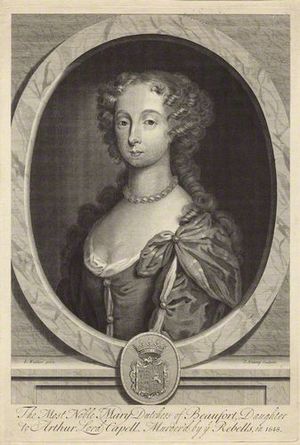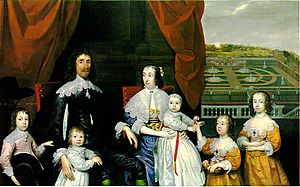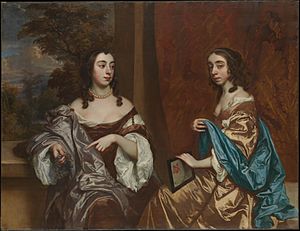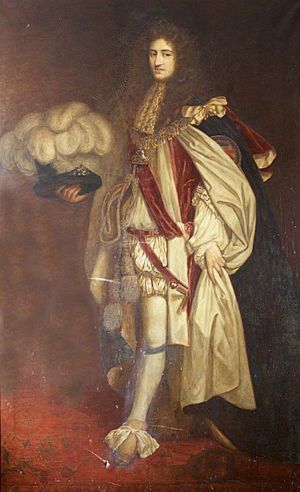Mary Somerset, Duchess of Beaufort (1630–1715) facts for kids
Quick facts for kids
The Duchess of Beaufort
|
|
|---|---|

Engraving by Joseph Nutting after Robert Walker
|
|
| Born | baptised 16 December 1630 Hadham Parva
|
| Died | 7 January 1715 (aged 84) |
| Resting place | St Michael and All Angels Church, Badminton |
| Nationality | English |
| Known for | 12 volume herbarium and introduction of exotic species to English gardening |
| Spouse(s) | |
| Children | 9, including Charles, Mary, Henrietta, and Anne |
| Scientific career | |
| Fields | Aristocrat and botanist |
| Influences |
|
Mary Somerset, Duchess of Beaufort (born 16 December 1630 – died 7 January 1715) was an English noblewoman. She was also a famous gardener and botanist. She was known by her maiden name, Mary Capell, and her first married name, Mary Seymour, Lady Beauchamp.
| Top - 0-9 A B C D E F G H I J K L M N O P Q R S T U V W X Y Z |
Early Life and Family Connections

Mary was born in Hadham Parva, Hertfordshire. She was baptised on 16 December 1630. Her parents were Sir Arthur Capell, 1st Baron Capell of Hadham and Elizabeth Morrison.
On 28 June 1648, Mary married her first husband, Henry Seymour, Lord Beauchamp. They had one son and one daughter together. Her husband was a Royalist, supporting the King during the English Civil War. He was even put in prison for his beliefs.
After her first husband passed away, Mary married Henry Somerset on 17 August 1657. He later became the 1st Duke of Beaufort. With him, she had six more children.
Mary was known for being very strict with her staff. She would check the house and gardens every day. If a servant was not working hard, they were quickly fired. Even other landowners respected her and tried not to upset her.
Mary Somerset: A Pioneer Botanist and Gardener

The Duchess of Beaufort was one of Britain's first important female gardeners. She started collecting plants seriously in the 1690s. Her interest in gardening grew even stronger after her second husband died.
She received help from famous gardeners and botanists like George London and Leonard Plukenet. Seeds for her collection came from all over the world. These places included the West Indies, South Africa, India, Sri Lanka, China, and Japan.
In 1702, she hired William Sherard to teach her grandson. Sherard helped her add more than 1500 new plants to her collection. Most of these were greenhouse plants. She kept them at Badminton House or at Beaufort House in Chelsea.
Other important scientists, like Sir Robert Southwell, Sir Hans Sloane, and Jacob Bobart, asked for her help. They needed her to grow and identify plants from unknown seeds. Some of these seeds came from the Royal Society of London.
Her home in London was right next to Sir Hans Sloane's house. This meant she was a neighbor of the Chelsea Physic Garden.
Mary's Plant Collections and Discoveries
Mary created a huge collection of dried plants, called a herbarium. It filled twelve large volumes. She left this amazing collection to Sir Hans Sloane in her will. He then gave it to the Natural History Museum.
She also had two volumes of beautiful drawings of her most special plants. These drawings were made by Everard Kickius. They are still kept in the library at Badminton House.
Mary introduced many new plants to British gardens. Most of these were greenhouse plants. Some of her introductions include Pelargonium zonale, which is a parent of many common garden pelargoniums. She also introduced ageratum and the Blue Passion Flower (Passiflora caerulea).
She was also one of the first women known to own a collection of Philosophical Transactions. This was the scientific journal of the Royal Society of London.
Personal Life and Legacy

With her first husband, Henry Seymour, Lord Beauchamp (who lived from about 1626 to 1654), she had two children:
- William Seymour, 3rd Duke of Somerset (died 1671)
- Lady Elizabeth Seymour (born around 1655 – died 1697) who married Thomas Bruce, 2nd Earl of Ailesbury.
With her second husband, Henry Somerset, 1st Duke of Beaufort (who lived from 1629 to 1700), she had several children:
- Henry Somerset, Lord Herbert (born before 1660), who died as a baby.
- Charles Somerset, Marquess of Worcester (1660-1698), who had a career in the military and politics.
- An unknown daughter Somerset (born before 1663).
- Lady Mary Somerset (1664-1733), who married James Butler, 2nd Duke of Ormonde.
- Lady Henrietta Somerset (around 1670-1715).
- Lord Arthur Somerset (1671-1743).
- Lady Anne Somerset (1673–1763).
Mary became a widow in 1700. She passed away on 7 January 1715 in Chelsea, London, England, at 84 years old. She was buried at St Michael and All Angels Church in Badminton, Gloucestershire.
Lasting Impact and Recognition
The plant group Beaufortia was named after her in the 1800s. This was done by botanist Robert Brown to honor her contributions to botany. These plants are found in Southwest Australia.
Several portraits were painted of Mary. Sir Godfrey Kneller painted her in 1708. Another portrait by Sir Peter Lely shows the Duchess with the Countess of Carnarvon. This painting is at the Metropolitan Museum of Art.
See also
 In Spanish: Mary Somerset para niños
In Spanish: Mary Somerset para niños

